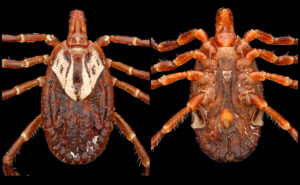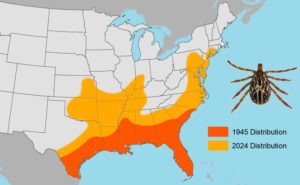
The Gulf Coast tick, Amblyomma maculatum. PHOTO COURTESY OF ARMY PUBLIC HEALTH CENTER
The Connecticut Agricultural Experiment Station (CAES) has confirmed the first locally acquired human disease case of Rickettsia parkeri rickettsiosis. The emerging tick-borne disease is transmitted by the Gulf Coast tick, Amblyomma maculatum, and is similar to Rocky Mountain spotted fever (RMSF).
Cases of the disease have been reported in the southeastern part of the country, but this is the first report of this disease in the Northeast.
“Rising global temperatures, ecological changes, reforestation and increases in commerce and travel are
important underlying factors influencing the rate and extent of range expansion of ticks and associated pathogens. It is anticipated that warming temperatures related to climate change may lead to the continued range expansion and abundance of several tick species, increasing their importance as emerging threats to humans, domesticated animals and wildlife,” said Dr. Goudarz Molaei, a research scientist and medical entomologist who also directs the Connecticut Agricultural Experiment Station’s (CAES’s) Passive Tick and Tick-Borne Disease Surveillance Program.
The Gulf Coast tick is a three-host tick and all feeding stages of this tick will bite humans. The distribution of this tick was considered restricted predominantly to coastal regions of states bordering the Gulf of Mexico and the southern Atlantic coast; however, in recent decades, its range has expanded northward into the mid-Atlantic states.

Map courtesy of Connecticut Agricultural Experiment Station
According to Dr. Molaei, the first established population of the Gulf Coast tick was reported in Fairfield County, Conn., in 2021, with a 30 percent infection with R. parkeri. Additional populations of this tick species with higher infections were later reported from New York and New Jersey in 2022 and 2024.
Because of similarities between Gulf Coast ticks and American dog ticks (Dermacentor variabilis, the principal vector of RMSF in the Northeast), these two species can be misidentified, Dr. Molaei said.
“Since most tick species are associated with a unique suite of pathogens, it is important to improve regional capacity for accurate detection and identification of ticks and the pathogens these transmit in the Northeast, an area already endemic for Lyme disease, RMSF, ehrlichiosis, anaplasmosis, babesiosis and Powassan virus disease,” he added.
Leave A Comment